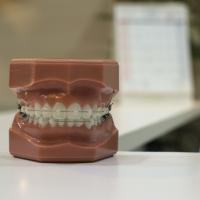Home > Blog > Skin and Body
How Do I Know Which Braces Are Right For Me?
If you’re thinking about having your teeth straightened, it might surprise you to know you have a wealth of options. Braces are the most common, and there are quite a few different types, each with their own benefits and drawbacks.
They’re so common, in fact, that over 4 million people in the U.S. wear them. In the past, dental braces used to be 100% metal, but technological advancements have resulted in all kinds of useful variations.
So, whether you’re considering them for you or a family member, you may be looking for more information. This article will run through some useful information on the different types of braces, in order for you to make an informed decision.
How can braces help me?
Braces are extremely common in today’s society, and that’s because they have a proven track record. A dentist will recommend braces to a patient in order to improve the appearance of their teeth. This can fix problems like crooked teeth, jaw disorders and overbites. They are supplied all over the world, and are the main solution to many teeth-based problems.
These braces, like those found at http://www.yesbraces.com/fairfax-office, are prescribed for people of all ages. If you think you need them you should get in touch with your dentist, and they’ll follow due course to help you out in the best way possible.
Over time, braces can help straighten out any teeth problems, literally. The structure that holds your teeth in place can slowly pull your pearly whites back to the correct position. This process can take months or years depending on the severity of the case.
-
The different types of braces
1. Ceramic braces
Ceramic braces are much akin to the standard metal braces you’ve probably seen people wear. The difference here is that the ceramic will allow the braces to blend better with your teeth. They do this by using clear or tooth-coloured brackets, and the result is a more translucent brace structure.
2. Standard, metal braces
The most standard, common type of brace, metal braces are made from a stainless steel bracket. As such, you won’t have to worry about it eroding or wearing down over time. These braces are more visible than ceramic ones as they don’t tend to use different colours.
Thankfully, modern metal braces are much smaller than their old counterparts. You probably saw that person in the movies with what looked like a cage in their mouth. That isn’t an issue anymore, and the ones you can get now are much more discreet.
If you’re struggling to live with this kind of brace, you can receive support from various health organisations. It can be a tricky situation to navigate, but you aren’t without help. The NHS (http://www.nhs.uk/Livewell/dentalhealth/Pages/braces.aspx) can provide you with lifestyle tips if you’re finding braces difficult.
3. Lingual braces
Lingual braces are almost identical to traditional metal braces, with one minor difference. The framework and wires are installed behind your teeth, which helps to keep them hidden. This can be helpful to those who want all the benefits of the stainless steel with less of the visibility.
4. Invisalign braces
As the name implies, invisalign braces are the hardest braces to spot. Instead of the brackets and wires found in standard braces, invisalign uses alignment trays that move your teeth gently. These aligners usually only last a couple of weeks, so it will be up to you to change them regularly. Check out invisalign braces in action here.
So, there’s a quick overview of braces! Hopefully you’re well on your way to that beautiful smile once again. Don’t let teeth problems get you down, because the perfect solution is within your grasp.
More to Read:
Previous Posts:






